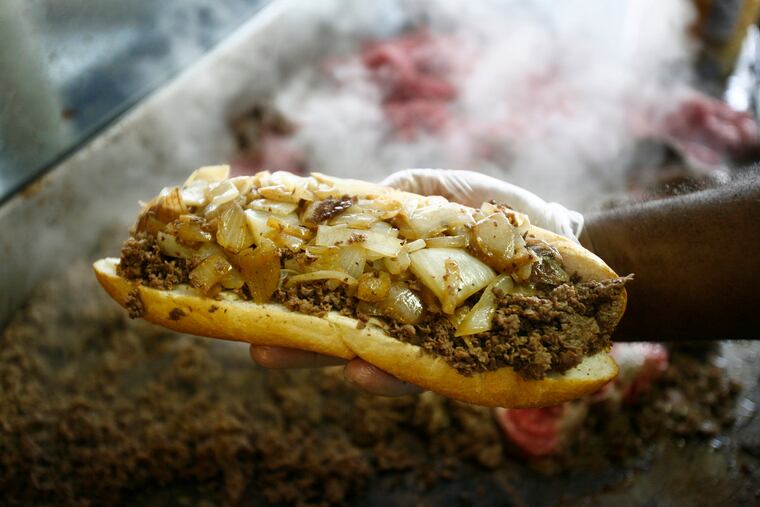Philly cheesesteak: Everything you need to know
Here’s a guide to Philadelphia’s most-famous sandwich.

It’s Philly’s most iconic sandwich, and there are a lot of opinions about it. Here’s what you need to know:
What is a cheesesteak?
It is a sandwich made of thinly sliced beef — usually frozen chip steak — cooked on a griddle and served on a sliced roll with cheese and either "wit" or "witout" onions. The cheese is typically American cheese, provolone or melted Cheez Whiz. Fans of cheesesteaks sold by particular outlets — think Pat's, Genos, Jim's, or Tony Lukes — usually point to the meat or the source of the eatery's bread as a reason for their loyalty.
Who invented the cheesesteak?
Brothers Pat (1907-1974) and Harry Olivieri (1916-2006) of South Philadelphia are credited with creating the steak sandwich in the 1930s while operating a hot dog stand on the triangle bordered by South 9th and Wharton Streets and Passyunk Avenue in South Philadelphia, site of the current Pat’s King of Steaks.
According to legend, Pat, weary of hot dogs, suggested that Harry go to a store and buy some beef. They sliced it up, grilled the beef with onions, and piled the mix on rolls. A taxi driver who stopped for a dog smelled the beef and asked for one of the sandwiches. They charged the cabbie and the steak sandwich was born.
In 1939, Harry Olivieri filed business-registration papers for several locations:
Pat's King of Steaks at the site of the hot dog stand
Million Dollar Steak Sandwich at 815 Wharton St., a row house a short walk from Pat's King of Steak's and the company's registration address
Pat's Steaks Sandwiches, 3251 Ridge Ave., in the Strawberry Mansion section near what was then a trolley turnaround and is now a bus station
Soon, the idea caught on and other steak sandwich shops opened, according to newspaper clippings of businesses opening or being sold.
But the key phrase here is "steak sandwich." Cheese was not part of the original equation.
>> READ MORE: Craig LaBan's favorite Philadelphia classic foods
So, when did the cheesesteak arrive?
The record here is murkier.
One story holds that a Pat's employee, Tony Lorenzo, who tired of the same old sandwich, added cheese about 20 years after Pat's opened. So that would put the birth of the cheesesteak sometime in the 50s. Others put the date at 1949.
According to Harry's grandson, Frank Olivieri Jr., Lorenzo worked at the Ridge Avenue location. Pat, he said, did not want to put cheese on the sandwiches in South Philadelphia.
"Pat never wanted cheese at his original shop because he tried to keep sort of kosher for all his Jewish friends," Frank Olivieri told the Inquirer in 2015. He said his father, Frank Sr., introduced cheese to the South Philly location.
>> READ MORE: Whiz on a cheesesteak: Hit or myth?
"Then my dad discovered Cheez Whiz, and it was perfect, because he could just hide the can at the edge of the grill where my grandfather wouldn't see it. He started serving it to people anyway, like, 'Try this!' and it became the most popular way to order."
The ingredients and cooking
The main ingredient is thinly sliced steaks from various cuts of beef, with rib-eye considered the top-of-the-shelf cut. The quality of the roll is also key to a cheesesteak connoisseur's appreciation of a sandwich. Torpedo rolls, known as submarine rolls in other parts of the country, are standard, though one highly rated purveyor — Donkey's, across the Delaware River in Camden — puts its cheesesteaks on kaiser rolls. The crust should be firm but not teeth-crunching hard. The inside should be tender but not chewy.
>> READ MORE: How the hoagie started: Truth, or a lot of baloney?
The meat is sautéed on a slightly oiled grill until cooked through. Salt and pepper are standard. Onions are often cooked on the same grill but are not married with the steak until it times to put them on the roll. There are different approaches when it comes to the cheese. Cheese slices can be placed on the bread before the steak, and softened by the heat of the meat. Or they can be put on the meat on the grill for a short time before placement on the roll. Cheez Whiz is melted and drizzled over the steak in the sandwich.
Cheesesteak lovers don't always use condiments, but if they do, it is likely to be ketchup. Peppers, hot and sweet, also are favorites, and Sriracha hot sauce seems to be catching hold.
>> READ MORE: How to make a cheesesteak
How to order a cheesesteak
"A cheesesteak wit," is what you say if you want onions.
"A cheesesteak witout," is what you say if you don't want onions.
That said, no one will mind if you're a stickler for proper diction and you order your cheesesteak "with" or "without" and complete the sentence with "onions."
At some locations, you may be asked to specify whether you want American cheese, provolone cheese or Cheez Whiz.
So, for example, you might order "One Whiz, wit (or witout)"; "One American, wit (or witout)"; or "One provolone, wit (or witout)"
Don't ask for Swiss cheese. Presidential candidate John Kerry made that mistake.
And don't even think of asking for rare, medium rare or medium. All cheesesteaks essentially are well-done.
How many calories in a cheesesteak
There is no fixed calorie amount for a cheesesteak due restaurant variations, but the estimates range from 900 to 1200 calories.
Without bread or cheese, Steak-umm, the Reading-based manufacture of frozen sliced steak found in most supermarkets, says a 32 gram (1.12 ounce) portion of cooked meat has 100 calories, 80 percent from fat.
Further reading
If you're interested in reading more about Philly cheesesteaks — and the weird stories they've prompted over the years — here's a sampling from our archives:
» READ MORE: Our best Philly tips: Read our most useful stories